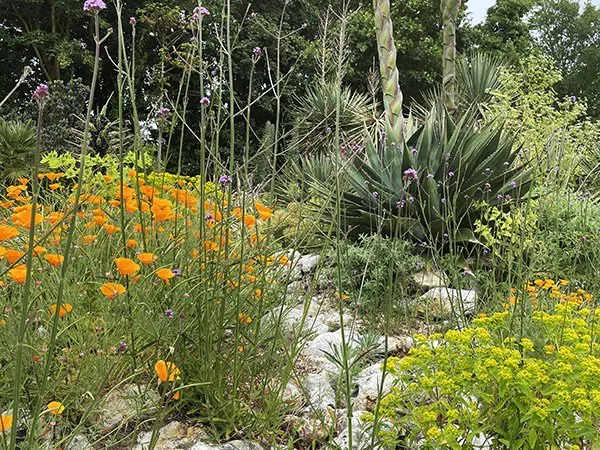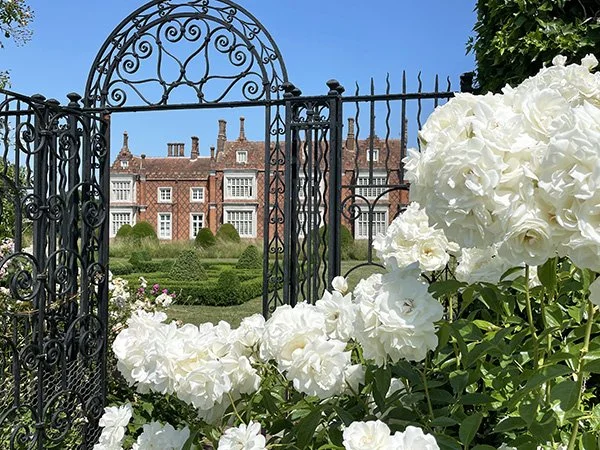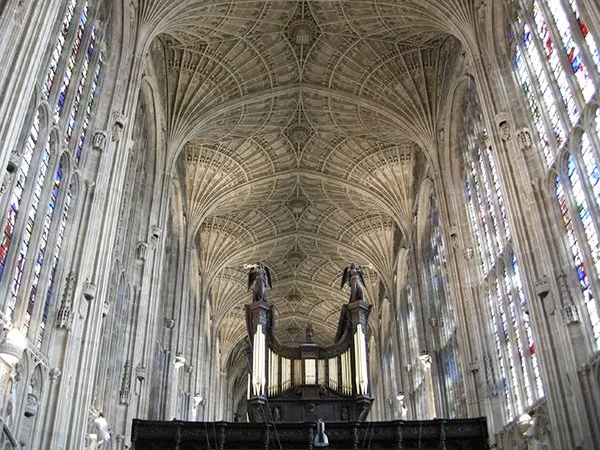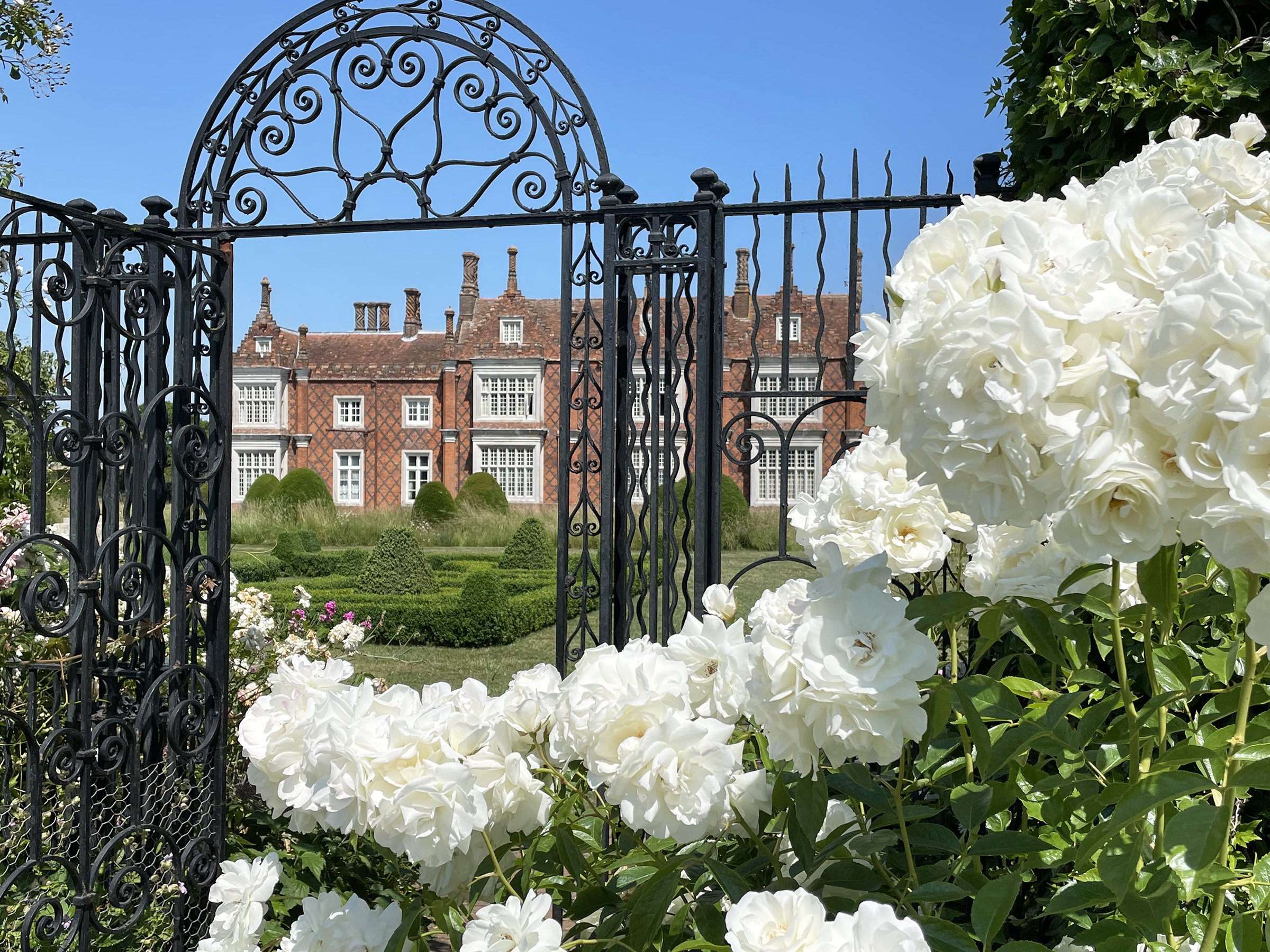
Cambridge & East Anglia
2604 | 10 to 17 June | 8 days | maximum number 12
Anglesey Abbey, Stow Hall, Houghton Hall, Old Manor Farmhouse, East Ruston Old Vicarage, Sandringham, Holkham Hall, Peter Beales Roses, Helmingham Hall, Beth Chatto Gardens, Place for Plants, RHS Garden Hyde Hall plus a day in the historic university town of Cambridge, a boat trip on the Norfolk Broads, time along the North Norfolk Coast and in Suffolk villages…
Big skies, stunning coast, rolling countryside…
Welcome to the Cambridge & East Anglia tour, a celebration of the finest gardens in East Anglia, from the extravagance and unconstrained ebullience of Alan Gray & Graham Robeson’s garden at East Ruston Old Vicarage, in Norfolk, to the quieter, peerless planting qualities of Beth Chatto’s garden in Essex.
East Anglia is the eastern region of England – the bit that sticks out into the North Sea – and comprises the counties Norfolk, Suffolk, Cambridgeshire and Essex and was, until July 2022, our adopted home for over thirty years.
We know the area well. Very Well. This was, until we moved to Scotland, our home tour, a tour that – in all its many editions – we ran each year, ever since we started the business over twenty-six years ago.
East Anglia, an ancient landscape firmly rooted in its agricultural past and, as one of Elizabethan England’s great wool areas, its rich farmland provided the wealth that gave England more medieval churches than anywhere else north of the Alps. More than anything, it’s an honest landscape. It’s not the Cotswolds, nor the Yorkshire Dales, and it doesn’t pretend to be.
We stay in two fabulous, tried-and-trusted hotels, with four nights on the North Norfolk Coast and three nights in rural Suffolk. We eat well too; indeed, we eat especially well.
Prices
Per person, sharing
3,320 GBP | 4,650 USD | 3.650 EUR
Prices are per person, sharing a double or twin room
Per person, single occupancy
3,950 GBP | 5,530 USD | 4.345 EUR
Prices are per person, for the single occupancy of one room
Prices, reservations & payments
Please read the Booking & Paying page and the comments in the additional information, below.
BOOK PLACES ON THIS TOUR
EXPRESS INTEREST & HOLD PLACES ON THIS TOUR
ASK QUESTIONS ABOUT THIS TOUR
Itinerary
Scroll down for additional information – maps of the tour area, hotels, eating etc.
D1 Wednesday, 10 June
Horse Chestnuts, Anglesey Abbey
Anglesey Abbey
Tim will meet you at the Sheraton Heathrow Hotel, immediately north of Terminal 5, Heathrow Airport, at 9.30 am. We’ll drive northeast to Anglesey Abbey for lunch and the early part of the afternoon, exploring its magnificent gardens.
Founded as the Hospital of St Mary in 1135, it became a Priory until the Dissolution of the Monasteries, when it was sold and became a house. Lord Fairhaven, son of British engineer Urban Hanlon Broughton, and his American wife, Cara Leland Rogers, daughter of oil tycoon Henry Huttleston Rogers, bought the Anglesey Abbey estate in the 1920s, and transformed the gardens. More history here…
Anglesey Abbey is about halfway on our journey to Blakeney, a charming former fishing village and once-important medieval port on the North Norfolk Coast.
We plan to arrive at the Blakeney Manor Hotel, our home for the next four nights, in good time to check in and relax before drinks and dinner at the hotel.
Today’s driving is about 175 miles/280 km
D2 Thursday, 11 June
Roses in the Walled Garden, Houghton Hall
Stow Hall & Houghton Hall
Our day begins at Stow Hall, a long-standing favourite of ours. It is largely the creation of the late Lady Hare, whose family have been here since 1553. Unusually, there’s no house, the last one being demolished in the mid-1990s, but thankfully, the gardens remain, with wonderful roses, magnificent trees and the walled garden, the star attractions.
We’ll continue to Houghton Hall for lunch and the afternoon at this magnificent house. Built in the 1720s for Sir Robert Walpole, Britain’s first Prime Minister, it is widely regarded as one of England’s finest houses and now the home of the 7th Marquess of Cholmondeley and his young family. The Walled Garden, laid out in 1991 as a memorial to Cholmondeley’s grandmother, Lady Sybil, is divided into several ornamental gardens, including a formal rose parterre, a spectacular double-sided herbaceous border, an Italian garden, fruit and vegetable gardens, and much more besides. An impressive abundance.
Then to the coast for dinner at the White Horse, a great gastro-pub at Brancaster Staithe.
Today’s driving is about 100 miles/160 km
D3 Friday, 12 June
The Desert Wash, East Ruston Old Vicarage
Old Manor & East Ruston
We start today at Old Manor Farmhouse, a 17th-century house rescued from dereliction in 1990 by Drs Paul and Sian Everden. The gardens had been lost, but the Everdens have created a series of interlinked garden rooms, in keeping with the period of the house. It’s a private garden and the Everdens open it on behalf of the National Garden Scheme (NGS).
Armed with picnics, we depart for Wroxham, in the heart of the Norfolk Broads, to take to the water and explore the waterways.
We’re not far from East Ruston Old Vicarage, where we’ll spend the afternoon in this influential contemporary garden. Alan Gray and Graham Robeson bought this remote vicarage in 1973, using it as a weekend retreat until 1986, when they made it their home and started gardening. Meticulous designers and accomplished plantsmen, both, they have created a wonderfully exuberant and extravagant garden.
We will dine at the nearby Ingham Swan, and drive home along the coast.
Today’s driving is about 90 miles/145 km

The North Norfolk Coast
Renowned for its spectacular coastline and its glorious beaches – to say nothing of its historic villages and market towns – the North Norfolk Coast is a designated National Landscape, an area of outstanding natural beauty, and a Site of Special Scientific Interest (SSSI) of European importance for wildlife.
Blakeney
Blakeney's sheltered haven brought it international importance and prosperity. It was granted a market charter in 1222 and, together with Cley, Wiveton and Salthouse, provided three ships for Edward II’s navy in 1322. By the early 15th century, Blakeney was one of the few ports permitted to trade in horses, gold and silver, which contributed to the town's growing wealth. Land reclamation and the silting up of navigable channels, coupled with increasingly larger vessels, brought its importance to an end.
D4 Saturday, 13 June
Rose arches, Stow Hall
Sandringham & Holkham Hall
We return westward to visit Sandringham, the estate Queen Victoria purchased for Prince Albert Edward’s 21st birthday. It remains the private property of The King and is one of the royal family’s favourite homes. We visit the house and superbly maintained gardens.
After lunch, at Sandringham, we’ll return to the coast road, stopping at Holkham Hall to visit their impressive Walled Garden, a six-acre garden laid out during the late 1700s and currently part-way through an extensive renovation project. The house itself, a Palladian house, based on designs by William Kent and built by Thomas Coke, 1st Earl of Leicester, sits within some 25,000 acres of rolling parkland and remains the home of the Coke family.
We’ll return early to Blakeney so that you have time to explore the village and, for those who wish to, walk out to see the seal colony on Blakeney Point or walk along the coastal footpath to Morston.
Dinner is at the hotel.
Today’s driving is about 80 miles/130 km
D5 Sunday, 14 June
Roses at Helmingham Hall
Peter Beales & Helmingham Hall
We depart Norfolk for Suffolk, stopping at Peter Beales Roses, the multi-award-winning rose growers and breeders, to visit the display garden, browse through the sales area and enjoy morning coffee in their bistro.
We’ll have lunch and the early afternoon at Helmingham Hall, the home of Xa Tollemache, a Chelsea Gold Medal-winning garden designer, and her family, who have lived here since the hall was completed in 1510. Sitting in its 400-acre deer park, the moated hall and its adjacent walled garden make quite a spectacle, and it’s easy to see why this is one of our customers’ favourite gardens.
Mid-afternoon, we’ll take to Suffolk’s lanes to the Swan at Lavenham, our hotel for the next three nights, where we plan to be in good time to check in and relax before drinks and dinner at the hotel. Lavenham is widely regarded as one of England’s finest medieval villages and, if we have time, we’ll have a short walk around the town before dinner.
Today’s driving is about 100 miles/160 km
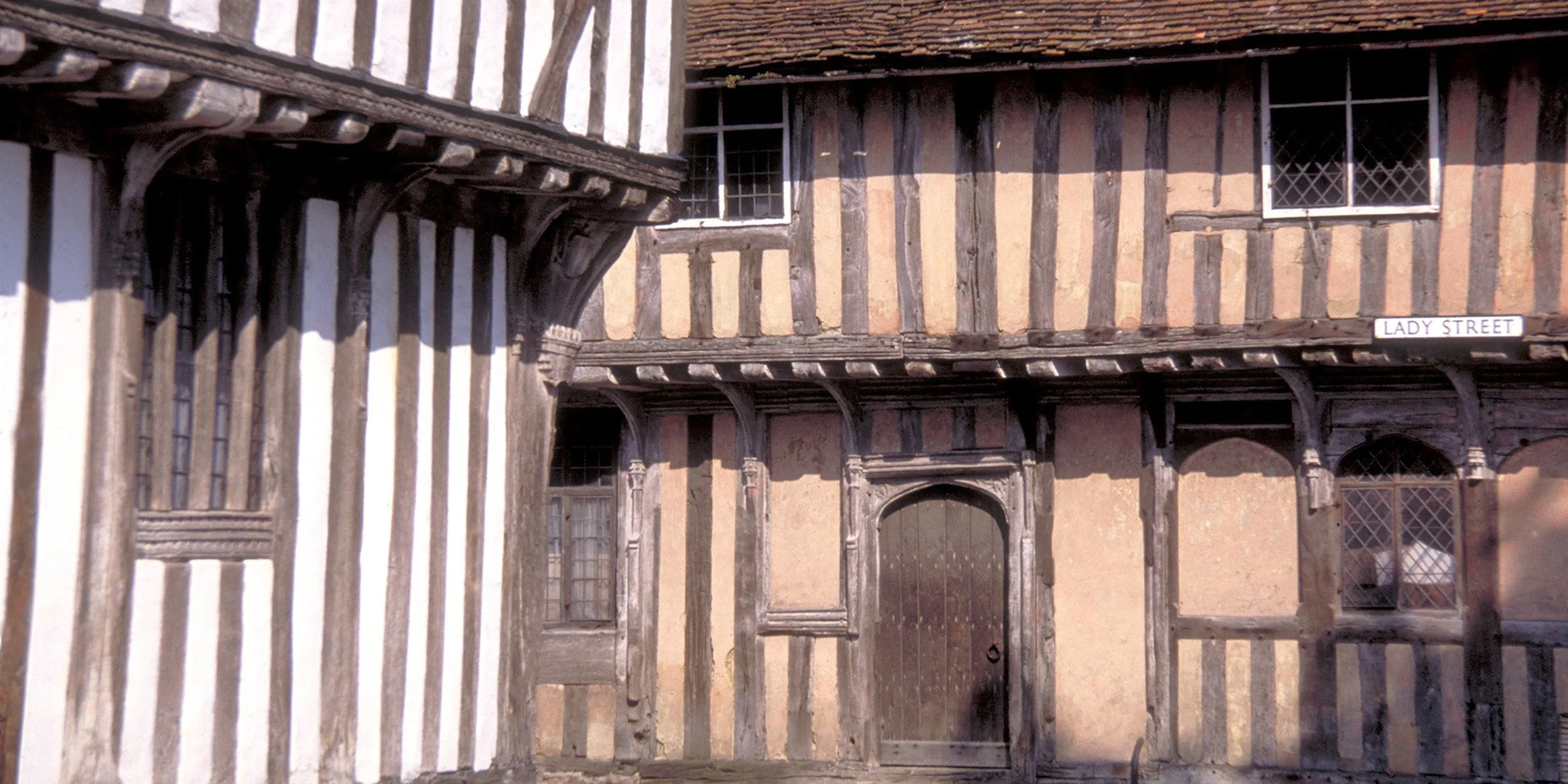
Lavenham
Lavenham is one of England’s best-preserved medieval towns.
It was granted its market charter in 1257 by Henry III and earned its wealth from the success of the wool and cloth trade. Merchants were drawn to the quality and reputation of Lavenham broadcloth and, by 1524, Lavenham was the 14th richest town in the country.
Wars and higher taxes, combined with Italian and Dutch imports, presaged the town’s decline.
Newly impoverished, the merchants couldn’t afford to follow the new architectural styles and, fortunately for us, their homes remain as they were built, without brick cladding and without being torn down.
D6 Monday, 15 June
The ceiling of King’s College Chapel
Cambridge
We spend the day in Cambridge – a city we rather prefer to Oxford. Sitting astride the River Cam, some 55 miles north of London, Cambridge was an important trading centre during the Roman and Viking ages, and today, it is an important modern and vibrant city at the heart of Silicon Fen, a high-tech hinterland and one of the world’s leading biomedical research clusters.
But it is the University for which Cambridge is most widely known. Founded in 1209, the University is one of the world's oldest teaching establishments, highly regarded for its academic achievement. It is, like Oxford, a confederation of Schools, Faculties and Colleges supporting over 20,000 students and more than 12,000 staff.
We will start the day with a walking tour of the historic centre of Cambridge, including entrance to King’s College Chapel, with the excellent Footprints Tours, the same company we use in Oxford, and end the day with a brief visit to the University Botanic Garden.
There will be some free time in between the Chapel and the Botanic Garden, and we’ll round off the day with dinner at Parker’s Tavern, something of a Cambridge institution.
Today’s driving is about 100 miles/160 km
D7 Tuesday, 16 June
The Water Garden, Beth Chatto’s
Lavenham & Beth Chatto’s
Before we go anywhere, we’ll start the day with a short guided walk of Lavenham, visiting its medieval Guildhall and Parish Church, and seeking out one or two of its finer houses.
We’ll then set off for Beth Chatto’s Gardens for lunch and the early afternoon. Famously, when Beth wanted to create a garden on the family fruit farm, her husband suggested she try some waste ground, known not to be fertile enough for fruit trees! But, over time, Beth created the internationally renowned gardens we see today. Necessarily perhaps, Beth was an early champion of finding the right plant for the right place and her Gravel Garden, which was once the original car park – and has never been watered – is a clear demonstration of her thinking and skill. It is a wonderful, skilful garden, full of simple, but ever so clever planting.
We’ll end the day with tea and a piece of cake at The Place for Plants, Rupert and Sara Eley’s charming garden and plant centre. A keen gardener since childhood, Rupert is the fourth generation of his family to garden at East Bergholt Place, his great-grandfather having laid out the gardens at the turn of the last century.
We will return to Lavenham and our hotel for drinks and our end-of-tour dinner.
Today’s driving is about 60 miles/100 km
D8 Wednesday, 17 June
Roses at RHS Garden Hyde Hall
RHS Garden, Hyde Hall
We leave this lovely, ancient market town and set off towards Heathrow Airport, stopping for a last visit, at RHS Garden, Hyde Hall, one of the Royal Horticultural Society’s five gardens.
Set on a hill, with far-reaching views, Hyde Hall is an oasis of peace and quiet, yet only some 30 minutes from North London. The garden was created in the 1950s by Dr and Mrs Robinson, who started with 60 trees on the hilltop and passed it on to the RHS in 1993. The 360 acres of gardens have been transformed and, today, it is several gardens, from a Dry Garden, with drought-resistant plants, to the Hilltop Garden, with roses and herbaceous borders.
The Sheraton Heathrow Hotel, where the tour ends, is about ninety minutes away, and we plan to be there at about 3 pm, in good time for evening flights home. If you are staying in the UK and don't need, or wish, to return to London or Heathrow, then please let us know your onward travel plans, so that we may assist you in getting to your next destination.
Today’s driving is about 120 miles/190 km
Tour area map
Our hotels
We are staying at two hotels.
Firstly, for the first four nights of the tour, at Blakeney Manor Hotel, on the North Norfolk Coast, and, secondly, for the final three nights of the tour, at The Swan at Lavenham, a famous and ancient establishment in the heart of the Suffolk countryside.
Eateries
We will dine at our hotels on the first and last evening of each stay, and dine out on the other three evenings at The White Horse, Brancaster Staithe, at The Ingham Swan and at Parker’s Tavern, in Cambridge.
We will have a picnic lunch on the Broads, and that is included in the price of the tour.
Other attractions
A boat trip on the Norfolk Broads, Norfolk’s coastal villages and medieval parish churches.
Cambridge has everything from the Scott Polar Research Institute to Kettle’s Yard, the must-see modern and contemporary art gallery.
And Suffolk has Lavenham and many other medieval villages to explore.
Bedrooms & upgrades
We have booked superior rooms (however described by the hotel) at both hotels.
Single travellers
Single travellers will have their own room, typically a small double room or, occasionally, a twin room.
Upgrades
If you would like to upgrade your room, please look at the hotel’s website and then contact us with your request.
Please do not contact the hotel directly.
Magnificent Cedar tree, Stow Hall
Joining instructions
The meeting arrangements are outlined in Day 1 of the itinerary, above, and will be confirmed by email some 12 weeks before the tour starts.
NB. The hotels we use as meeting points are chosen because of their location, the ease of access for the minibus and because they afford our customers, whether staying there or not, a comfortable and secure place to wait.
It is not because we endorse the hotel.
Accuracy & faithfulness
When describing the tour, we try to be accurate and, when undertaking the tour, we try to be faithful to the itinerary. However, changes can occur, either necessarily or unavoidably, and we ask for your understanding when this happens.
Useful links
Click here for some useful links to other websites, notably tourism, heritage, horticultural, cultural organisations and travel and transport websites.
Please let us know if any links are dysfunctional.
Acknowledgements
Finally, we would like to acknowledge the assistance of the many guide books and websites we use in planning our tours.
Thank you.


